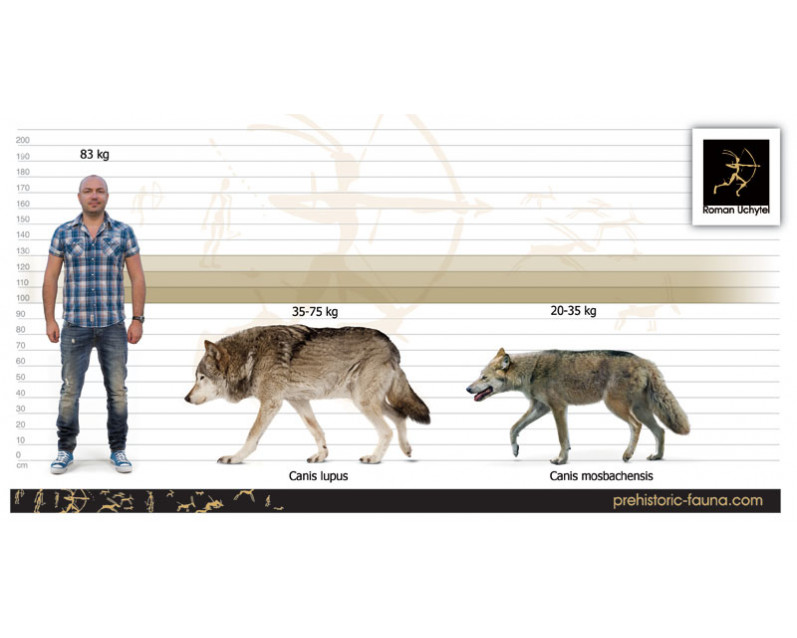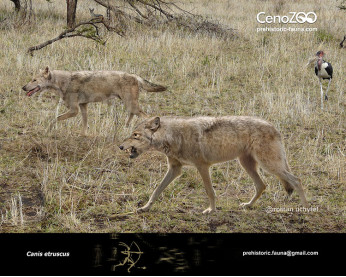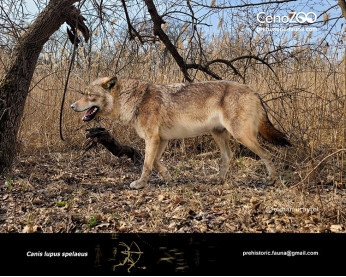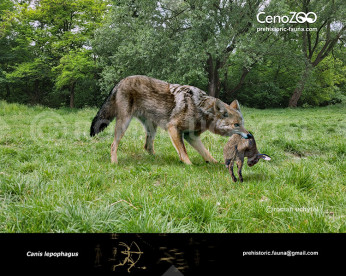Мосбахський вовк (Canis mosbachensis)
394394Mosbach wolf (Canis mosbachensis (Soergel, 1925))
Canis Mosbachensis
Canis lupus variabilis
Order: Carnivora
Family: Canidae
Temporal range: during the Middle Pliocene - Late Pleistocene (Eurasia)
Dimensions: length - 1,3 m, height - 50 - 75 сm, weight - 20 - 35 kg
Canis mosbachensis, sometimes known as the Mosbach wolf, is an extinct small wolf that once inhabited Eurasia from the Middle Pleistocene era to the Late Pleistocene. It is widely accepted as the ancestor of Canis lupus, the gray wolf.
The holotype of the Mosbach wolf Canis mosbachensis Soergel, 1925 was found in Jockgrim, Germany. In 2010, a study found that the diversity of the Canis group decreased by the end of the Early Pleistocene to Middle Pleistocene and was limited in Eurasia to two types of wolves. These were the small wolves of the C. mosbachensis and C. variabilis group that were a comparable size to the extant Indian wolf (Canis lupus pallipes), and the large hypercarnivorous Canis (Xenocyon) lycaonoides that was comparable in size to extant northern gray wolves.
The Mosbach wolf occurred in time between C. etruscus in the Early Pleistocene and the modern C. lupus.The Mosbach wolf was smaller than most North American wolf populations and smaller than C. rufus, and has been described by Kurten as being similar in size to Canis papilles, the Indian wolf. As wolves continue to evolve they become bigger. Nowak proposed that C. mosbachensis was the ancestor of Eurasian and North American wolves, and that one population of C. mosbachensis invaded North America where it became isolated by the later glaciation and there gave rise to C. rufus. Another population of C. mosbachensis remained in Eurasia and evolved into C. lupus, from where it invaded North America.
The true gray wolves made their appearance at the end of the Middle Pleistocene at about 0.5–0.3 million years before present.
Canis variabilis, sometimes known as the Zhoukoudian wolf, is an extinct small wolf that once inhabited part of what is now China and Yakutia. Richard H. Tedford compared C. mosbachensis (which was once distributed from Western Europe to Kazakhstan) with C. variabilis (which was once distributed from Kazakhstan to China) because they both existed in the Middle Pleistocene across mid-latitude Eurasia. The only difference he noted was that C. variabilis had "nasal bones that terminate at or anterior to the most posterior position of the frontal-maxillary suture", and therefore he proposes these two taxa to represent a variation in the one geographically widespread mid-Pleistocene wolf.
In 2018, a study proposed that Canis variabilis should be recognized as Canis mosbachensis variabilis, an east Eurasian subspecies of the west Eurasian Canis mosbachensis. The difference is that C. m. variabilis possesses a shorter nasal bone and a slight variation in the ridge of the first upper molar tooth. The craniodental characteristics of C. m. variabilis are more evolved and indicate that it was less of a hypercarnivore than Canis chihliensis, the European Canis etruscus and Canis arnensis, but was less evolved and less of a hypercarnivore than Canis lupus. It is not a direct ancestor of Canis lupus but was a close relative.
Mosbach wolf (Canis mosbachensis (Soergel, 1925))
Canis Mosbachensis
Canis lupus variabilis
Order: Carnivora
Family: Canidae
Temporal range: during the Middle Pliocene - Late Pleistocene (Eurasia)
Dimensions: length - 1,3 m, height - 50 - 75 сm, weight - 20 - 35 kg
Canis mosbachensis, sometimes known as the Mosbach wolf, is an extinct small wolf that once inhabited Eurasia from the Middle Pleistocene era to the Late Pleistocene. It is widely accepted as the ancestor of Canis lupus, the gray wolf.
The holotype of the Mosbach wolf Canis mosbachensis Soergel, 1925 was found in Jockgrim, Germany. In 2010, a study found that the diversity of the Canis group decreased by the end of the Early Pleistocene to Middle Pleistocene and was limited in Eurasia to two types of wolves. These were the small wolves of the C. mosbachensis and C. variabilis group that were a comparable size to the extant Indian wolf (Canis lupus pallipes), and the large hypercarnivorous Canis (Xenocyon) lycaonoides that was comparable in size to extant northern gray wolves.
The Mosbach wolf occurred in time between C. etruscus in the Early Pleistocene and the modern C. lupus.The Mosbach wolf was smaller than most North American wolf populations and smaller than C. rufus, and has been described by Kurten as being similar in size to Canis papilles, the Indian wolf. As wolves continue to evolve they become bigger. Nowak proposed that C. mosbachensis was the ancestor of Eurasian and North American wolves, and that one population of C. mosbachensis invaded North America where it became isolated by the later glaciation and there gave rise to C. rufus. Another population of C. mosbachensis remained in Eurasia and evolved into C. lupus, from where it invaded North America.
The true gray wolves made their appearance at the end of the Middle Pleistocene at about 0.5–0.3 million years before present.
Canis variabilis, sometimes known as the Zhoukoudian wolf, is an extinct small wolf that once inhabited part of what is now China and Yakutia. Richard H. Tedford compared C. mosbachensis (which was once distributed from Western Europe to Kazakhstan) with C. variabilis (which was once distributed from Kazakhstan to China) because they both existed in the Middle Pleistocene across mid-latitude Eurasia. The only difference he noted was that C. variabilis had "nasal bones that terminate at or anterior to the most posterior position of the frontal-maxillary suture", and therefore he proposes these two taxa to represent a variation in the one geographically widespread mid-Pleistocene wolf.
In 2018, a study proposed that Canis variabilis should be recognized as Canis mosbachensis variabilis, an east Eurasian subspecies of the west Eurasian Canis mosbachensis. The difference is that C. m. variabilis possesses a shorter nasal bone and a slight variation in the ridge of the first upper molar tooth. The craniodental characteristics of C. m. variabilis are more evolved and indicate that it was less of a hypercarnivore than Canis chihliensis, the European Canis etruscus and Canis arnensis, but was less evolved and less of a hypercarnivore than Canis lupus. It is not a direct ancestor of Canis lupus but was a close relative.

-797x638.jpg)
2-797x638.jpg)

-70x56.jpg)
2-70x56.jpg)



-lycanoides-346x277.jpg)

